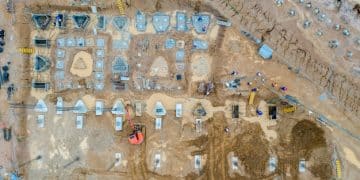US Construction Labor Shortage: Mitigating Delays in 2025

Anúncios
The US construction industry faces a severe labor shortage, necessitating a multi-faceted approach, including technology adoption, improved training, and strategic workforce planning, to mitigate project delays and ensure industry stability in 2025.
The construction industry in the United States is at a critical juncture, facing what many describe as an unprecedented labor shortage. This issue isn’t new, but its implications are becoming increasingly pronounced, threatening project timelines, escalating costs, and impacting overall economic stability. Addressing the US Construction Labor Shortage: Strategies for Mitigating Delays in 2025 is not merely an operational challenge; it’s a strategic imperative that demands innovative solutions and a reevaluation of traditional practices.
Understanding the Core of the US Construction Labor Shortage
The persistent labor shortage in the US construction sector is a complex phenomenon, rooted in a confluence of factors that have evolved over recent decades. It’s not simply a matter of too few workers, but a systemic issue that impacts project timelines and overall industry health. This scarcity of skilled labor creates a ripple effect, leading to increased competition for talent, higher labor costs, and, crucially, project delays that can span months or even years.
One significant contributor to this deficit is the aging workforce. A substantial portion of experienced construction professionals are nearing retirement, taking with them decades of invaluable knowledge and practical skills. This demographic shift isn’t being adequately compensated by new entrants into the field. Many younger generations are not entering traditional trades, often opting for careers perceived as less physically demanding or offering clearer pathways to higher education and white-collar employment. This societal shift in career preferences directly impacts the pipeline of future construction workers.
Furthermore, post-recession challenges significantly reduced the number of skilled workers. Many left the industry during the economic downturns, and not all returned when the market recovered. Apprenticeship programs, a traditional cornerstone for skill development in construction, also saw reduced enrollment and funding, creating a gap in vocational training. This lack of robust training pathways restricts the influx of new, well-prepared talent into the workforce. The perception of construction as a physically demanding, often dangerous career without sufficient opportunities for advancement further deters potential recruits. Overcoming this perception requires a concerted effort from industry leaders and educators to highlight the evolving nature of construction, which now heavily integrates technology and offers diverse career paths beyond manual labor.
In a competitive labor market, the construction industry often struggles to compete with sectors that offer seemingly better benefits, more stable hours, or more attractive work environments. This competitive disadvantage exacerbates the shortage, making it harder to attract and retain the best talent. The lack of diversity within the workforce also contributes to the problem, as the industry has traditionally struggled to attract women and minority groups, thereby limiting its talent pool. Addressing these foundational issues requires a holistic approach that tackles both immediate recruitment needs and long-term structural changes within the industry.
Embracing Technology and Automation to Bridge the Gap
In the face of the ongoing labor shortage, technology and automation are emerging as powerful allies for the construction industry. These advancements are not merely about efficiency; they are becoming essential tools for mitigating project delays and compensating for the scarcity of human labor. Integrating innovative technologies can significantly transform how projects are managed and executed, leading to more streamlined processes and reduced reliance on large, manual workforces.
Leveraging Digital Tools for Enhanced Efficiency
Project management software, building information modeling (BIM), and integrated digital platforms are no longer luxuries but necessities. These tools enable better coordination, reduce errors, and improve decision-making, which in turn minimizes rework and delays.
- BIM (Building Information Modeling): Facilitates comprehensive project visualization and collaboration, identifying clashes early.
- Project Management Software: Streamlines scheduling, resource allocation, and progress tracking.
- Cloud-Based Collaboration Platforms: Enhances real-time communication between all stakeholders, from site to office.
Robotics and Automation on the Jobsite
The deployment of robotics and automated machinery is revolutionizing physically demanding and repetitive tasks. While not replacing human workers entirely, these technologies can perform tasks with greater precision and speed, reducing the need for extensive manual labor.
- Robotic Masonry: Automates bricklaying, accelerating wall construction.
- Autonomous Heavy Equipment: Enhances safety and efficiency in excavation and material handling.
- Pre-fabrication and Modular Construction: Shifts labor from unpredictable jobsite conditions to controlled factory environments, enhancing quality and speed.
These technologies not only address the labor deficit but also improve site safety, reduce material waste, and can deliver higher quality outputs. The investment in these areas is crucial for companies looking to maintain competitiveness and deliver projects on schedule. Early adoption and scaled implementation of such technologies can provide a significant advantage in managing project timelines and operational costs in a tight labor market. The future of construction clearly involves a harmonious blend of human expertise and technological prowess.
Investing in Workforce Development and Training Programs
Effective workforce development and robust training programs are indispensable strategies for combating the US construction labor shortage. Merely attracting new talent isn’t enough; the industry must actively invest in upskilling and reskilling its current and future workforce to meet the evolving demands of modern construction. This proactive approach ensures that workers possess the diverse skill sets necessary for technologically advanced projects.
Revamping Apprenticeship and Vocational Training
Traditional apprenticeship programs need revitalization to become more appealing and accessible. This involves collaborating with educational institutions, trade schools, and community colleges to develop curricula that meet industry needs. Emphasis should be placed on practical, hands-on training combined with theoretical knowledge, ensuring a well-rounded skill set.
- Industry-Academia Partnerships: Creating direct pipelines from vocational schools to construction sites.
- Modernizing Curriculum: Incorporating new technologies like BIM, drones, and automation tools.
- Financial Incentives: Offering scholarships, grants, or paid apprenticeships to reduce financial barriers for prospective trainees.
Continuous Upskilling for Existing Workers
The rapid evolution of construction technologies necessitates continuous learning for the current workforce. Companies should implement regular training sessions, workshops, and certification programs to keep employees’ skills current. This not only enhances productivity but also improves employee retention by demonstrating an investment in their professional growth.
- Cross-Training Initiatives: Empowering workers with multiple competencies to increase flexibility and reduce downtime.
- Safety Certifications: Ensuring all workers are up-to-date with the latest safety protocols and equipment usage.
- Leadership Development: Preparing experienced workers for supervisory and management roles to fill critical gaps.
By prioritizing these development initiatives, the construction industry can build a more skilled, adaptable, and resilient workforce. This investment in human capital is crucial for mitigating project delays and ensuring long-term sustainability. A well-trained workforce is not just about filling vacancies; it’s about fostering a culture of excellence and continuous improvement, which directly translates to more efficient project delivery and higher quality outcomes. This strategic focus on training contributes significantly to retaining talent and attracting new individuals who see clear pathways for growth and development within the sector.

Improving Recruitment and Retention Strategies
Addressing the US construction labor shortage is fundamentally about attracting and keeping talent. Traditional recruitment methods are often insufficient in today’s competitive market, demanding innovative and inclusive strategies. Alongside recruitment, robust retention programs are crucial to ensure that once skilled workers are on board, they choose to stay.
Expanding the Talent Pool
The construction industry traditionally struggles with a lack of diversity. Actively recruiting from underrepresented groups—including women, minorities, and veterans—can significantly broaden the talent pool. This requires targeted outreach programs and a conscious effort to challenge existing stereotypes.
- Targeted Outreach Programs: Partnering with community organizations and veteran support groups.
- Promoting Diversity and Inclusion: Creating an environment where all individuals feel welcome and valued.
- Highlighting Career Advancement: Showcasing clear career paths and opportunities for growth within the industry.
Additionally, rethinking hiring criteria to focus on aptitude and willingness to learn, rather than just prior experience, can open doors for a wider range of candidates. Entry-level positions combined with comprehensive training programs can provide a pathway for individuals new to the industry.
Enhancing Employee Retention
Recruiting new workers is only half the battle; retaining them is equally, if not more, important. High turnover rates exacerbate the labor shortage and increase recruitment costs. Companies must focus on creating positive work environments, offering competitive compensation, and investing in employee well-being.
- Competitive Compensation and Benefits: Offering attractive wages, health benefits, and retirement plans.
- Work-Life Balance: Implementing flexible scheduling where possible and recognizing the importance of downtime.
- Safety Culture: Prioritizing worker safety through rigorous protocols and providing proper equipment.
- Recognition and Growth: Acknowledging hard work, providing constructive feedback, and offering opportunities for skill development.
By implementing these comprehensive recruitment and retention strategies, construction companies can create a more stable and satisfied workforce. This not only mitigates the immediate challenges of labor shortages but also builds a more resilient and attractive industry for the future, ensuring a steady supply of skilled professionals. The long-term success of the industry hinges on its ability to evolve its approach to talent management.
Fostering a Culture of Safety and Well-being
The construction industry has historically faced challenges related to safety and worker well-being, which directly impact its attractiveness as a career path and influence retention rates. Cultivating a robust culture of safety and prioritizing employee well-being are not merely ethical obligations; they are strategic imperatives for mitigating the US construction labor shortage and ensuring project continuity. When workers feel safe and valued, productivity increases, and turnover decreases, directly impacting project timelines.
Implementing Comprehensive Safety Programs
Beyond regulatory compliance, leading construction firms are adopting proactive and preventative safety measures. This includes regular safety training, investment in advanced safety equipment, and fostering an environment where every worker feels empowered to identify and report hazards without fear of reprisal.
- Regular Safety Audits: Conducting frequent, thorough inspections to identify potential risks.
- Personal Protective Equipment (PPE): Ensuring access to and proper usage of high-quality, comfortable PPE.
- Near-Miss Reporting Systems: Encouraging the reporting of incidents that could have led to a mishap, allowing for preventative action.
A strong safety culture significantly reduces accidents, minimizing lost workdays and avoiding delays caused by injuries or investigations. It also enhances the industry’s reputation, making it more appealing to prospective workers and retaining existing ones.
Prioritizing Mental and Physical Well-being
The demanding nature of construction work can take a toll on workers’ physical and mental health. Companies that invest in well-being initiatives demonstrate genuine care for their employees, which contributes to higher morale and lower absenteeism.
- Access to Health and Wellness Programs: Offering resources for physical fitness, nutrition, and stress management.
- Mental Health Support: Providing confidential counseling services and promoting open discussions about mental well-being.
- Fair Work Hours: Avoiding excessive overtime that can lead to burnout and fatigue.
By creating a supportive and healthy work environment, companies can enhance worker satisfaction and loyalty. This commitment to well-being acts as a powerful retention tool, as employees are more likely to stay with employers who prioritize their health and safety. Ultimately, a safe and healthy workforce is a productive workforce, directly contributing to the on-time and on-budget delivery of projects. This focus helps the industry shed its “dangerous job” image and attracts a more diverse and skilled talent pool.
Leveraging Government and Industry Partnerships
Addressing a systemic issue like the US construction labor shortage requires collaborative efforts that extend beyond individual firms. Partnerships between government entities, industry associations, and educational institutions are crucial for developing comprehensive, long-term solutions. These collaborations can unlock funding, streamline regulatory processes, and create unified strategies to attract, train, and retain talent.
Government Initiatives and Funding
Government support can significantly bolster workforce development efforts through grants, tax incentives, and policy changes. Advocating for policies that favor vocational training and infrastructure investment directly benefits the construction labor market.
- Investing in Vocational Schools: Government funding for state-of-the-art training facilities and updated curricula.
- Apprenticeship Tax Credits: Incentives for companies to host and train apprentices, reducing the financial burden.
- Infrastructure Spending: Government projects create stable demand for construction labor, encouraging career entry.
Moreover, streamlined immigration policies for skilled workers in critical trades could provide a short-term relief, although the long-term solution lies in domestic workforce development. Engaging with policymakers to highlight the economic impact of the labor shortage can lead to more favorable legislation and support.
Industry Association Collaboration
Industry associations play a pivotal role in setting standards, advocating for the sector, and facilitating knowledge sharing. Companies should actively participate in these associations to contribute to and benefit from collective initiatives aimed at addressing the labor crisis.
- Unified Recruitment Campaigns: Associations can launch national campaigns to improve the image of construction careers.
- Best Practice Sharing: Facilitating forums where companies can share successful strategies for recruitment, training, and retention.
- Data Collection and Analysis: Providing valuable insights into labor market trends to inform strategic planning.
Through these partnerships, the construction industry can present a united front, magnifying its voice and influence in advocating for necessary changes. This collaborative approach ensures resources are optimized, efforts are synchronized, and the impact on mitigating project delays is maximized. By working together, stakeholders can build a more resilient and attractive future for the US construction workforce.

Strategic Workforce Planning and Forecasting
Effective strategic workforce planning and accurate forecasting are indispensable tools for construction companies aiming to mitigate project delays in the face of labor shortages. This forward-looking approach allows firms to anticipate future talent needs, identify potential gaps, and proactively implement solutions rather than reacting to crises. It transforms human resource management from a reactive function to a strategic asset.
Anticipating Future Labor Needs
Workforce planning involves analyzing current project pipelines, projected industry growth, and anticipated retirements to forecast future labor demands. This requires sophisticated data analytics and close collaboration between project management, human resources, and business development teams.
- Projected Workload Analysis: Assessing the volume and type of projects expected over the next 3-5 years.
- Demographic Analysis: Understanding the age profile of the current workforce and potential retirement rates.
- Skill Gap Identification: Pinpointing specific trades or technical skills that are likely to be in short supply.
By understanding these future needs, companies can begin developing talent pipelines, whether through internal training, external recruitment, or strategic partnerships. This foresight is critical for maintaining a stable and competent workforce.
Developing Proactive Mitigation Strategies
Once potential labor gaps are identified, strategic planning enables the development of tailored mitigation strategies. This isn’t just about hiring; it’s about optimizing existing resources and exploring alternative approaches to project execution.
- Contingency Planning: Developing backup plans for critical roles or projects in case of unexpected labor availability issues.
- Cross-Functional Training: Training existing employees in multiple skill sets to create a more versatile workforce.
- Automation Integration Roadmaps: Planning the phased introduction of new technologies to reduce manual labor dependency.
- Outsourcing and Subcontracting Strategies: Building relationships with reliable partners to scale operations up or down as needed.
Strategic workforce planning allows companies to be agile and adaptable, ensuring that projects can progress even when faced with broader industry labor constraints. It frames the labor shortage not just as a problem, but as an opportunity for innovation in how work is organized and executed. This proactive approach minimizes disruption, reduces delays, and enhances overall business resilience.
| Key Strategy | Brief Description |
|---|---|
| ⚙️ Technology Adoption | Integrating BIM, robotics, and automation to enhance efficiency and reduce manual labor dependency. |
| 📚 Workforce Development | Revamping vocational training, apprenticeships, and offering continuous upskilling for current workers. |
| 🤝 Recruitment & Retention | Expanding talent pools, improving compensation, fostering work-life balance, and prioritizing recognition. |
| 📊 Strategic Planning | Anticipating future labor needs, identifying skill gaps, and developing proactive contingency plans. |
Frequently Asked Questions
The primary causes include an aging workforce retiring, a lack of new entrants into skilled trades, reduced vocational training, changing perceptions of manual labor, and competition from other industries. Post-recession job shifts also contributed, as many workers did not return to construction.
Technology mitigates delays by increasing efficiency and reducing manual labor dependency. Tools like BIM improve coordination, while robotics and automation handle repetitive or hazardous tasks. Pre-fabrication and modular construction also shift work to controlled environments, accelerating project delivery.
Training programs are crucial for upskilling the existing workforce and preparing new talent. Revitalized apprenticeships, vocational training, and continuous cross-training ensure workers have the diverse skills needed for modern construction, directly addressing skill gaps and improving productivity.
Improving recruitment broadens the talent pool by attracting underrepresented groups, while retention strategies reduce costly turnover. Offering competitive pay, better work-life balance, and a strong safety culture makes the industry more attractive, ensuring a stable and skilled workforce for projects.
Partnerships can secure funding for training initiatives, streamline regulations, and facilitate knowledge sharing. Government support through policies and investment, coupled with industry associations unifying efforts, creates a comprehensive approach to attract, train, and retain a robust construction workforce.
Conclusion
The **US construction labor shortage** presents a multifaceted challenge that demands a strategic, cohesive response across the industry. Mitigating project delays in 2025 and beyond will hinge on the industry’s collective ability to evolve beyond traditional methods. This requires a commitment to leveraging technological advancements like BIM and robotics, revitalizing workforce development programs, and implementing innovative recruitment and retention strategies. Furthermore, fostering a culture that prioritizes safety and well-being, coupled with strong partnerships between government, industry, and educational institutions, is paramount. By embracing these integrated approaches, the construction sector can build a more resilient, skilled, and attractive workforce, ensuring the timely delivery of vital projects and sustained economic growth.





